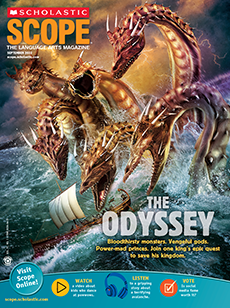“Stinky Pits: A History” (30 minutes)
Read the article as a class. Briefly discuss anything students find interesting or surprising. Then discuss the following questions.
Close-Reading Questions
- What literary device does author Kristin Lewis use in the first paragraph of the introduction? What purpose does it serve? (figurative language) Lewis uses a simile to describe the oppressive heat in New Jersey during the summer of 1912. The simile draws readers into the story by helping transport them to the scene Lewis is describing.
- Why does Lewis include the details about ancient Egyptians dabbing their wrists with fragrant pastes and ancient Greeks scraping their sweaty skin? (text structure) These details support the idea that humans have long searched for ways to improve the way they smell.
- What role did advertising play in the growth of the antiperspirant and deodorant industry? (central ideas) Advertising played a large role in the growth of the antiperspirant and deodorant industry. Before Murphey and Young created advertisements that implied women needed antiperspirant, sweat wasn’t seen as a problem. After the advertisements hit the market, Odorono’s sales went up. When advertisements targeting men were created, the antiperspirant and deodorant industry expanded further.
- In the section “Scared About Stink,” what does Lewis’s attitude toward Young’s campaign seem to be? In other words, what is Lewis’s tone in this part of the article? (tone) Lewis’s attitude toward Young’s campaign seems to be disapproving. She writes that Young’s ads “preyed on women’s insecurities.” This shows that Lewis might not agree with Young’s methods.
- How does the information in the timeline relate to the rest of the article? (text features) The timeline provides additional details to support a key idea of the article: Throughout history, humans have searched for ways to make themselves and the world around them smell better.
“The Science of Smell” (15 minutes)
Read the informational text as a class and respond to the following questions, some of which refer to both texts.
Close-Reading Questions
- On page 19, Lewis writes, “These smell sensors transmit messages to your brain, kind of like how your phone transmits text messages to your friends.” What does this comparison help the reader understand? Explain. (figurative language) This comparison helps the reader understand how smell sensors work by comparing them with something familiar: a phone.
- If something is subjective, it is based mainly on opinions or feelings rather than on facts—so it can vary from person to person. According to “The Science of Smell,” can appealing smells be subjective? Explain. (key ideas and supporting details) Yes, what smells good and bad can be subjective. On page 19, author Kristin Lewis writes, “Generally speaking, though, smells that are tantalizing to one person can be totally repulsive to another.” The fact that people do not all find the same smells appealing supports the idea that our sense of what smells appealing is subjective.
Critical-Thinking Questions
- How does reading both “Stinky Pits: A History” and “The Science of Smell” give you a better understanding of smell? By reading both texts, readers learn not only about how humans’ perception of body odor and smell has varied across cultures and time, but also about how our sense of smell works scientifically.
- According to information in “Stinky Pits: A History,” how did scientific knowledge—or a lack of it—affect human hygiene? According to the article, a lack of scientific knowledge about diseases and how they spread caused people to view the importance of hygiene differently throughout history. In the 15th century, people thought bathing would leave them vulnerable to disease, so they avoided it. During the Civil War, it was discovered that disease could be prevented by washing germs away, so hygiene became much more common.
- Do you think it was wrong of Murphey and Young to prey on people’s insecurities to sell a product? Or was what they did simply a smart business decision? Answers will vary. Some students may say that yes, it was wrong to prey on people’s insecurities to convince those people to buy a product because doing so manipulated and exploited them for profit. Others might say that it was not wrong; advertisers need to draw on human insecurities in their campaigns, and it’s not as though people don’t ultimately have the choice of whether or not to buy a product.


